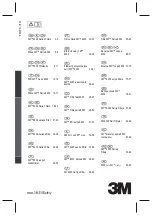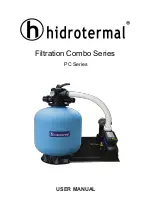
41
Salinity Probe Calibration
Salinity is a measurement of dissolved solids in liquid: these solids will conduct electricity to
varying degrees. A special probe is used, with two electrical contacts in it, to determine the
resistance to the flow of electricity in the liquid. The higher the resistance, the lower the PPM
of dissolved solids.
In the Spectra Watermakers systems, the salinity probe is located just before the diversion
valve, at the output of the RO membrane. This way we can look at the salinity level of the
product water before deciding to either reject the water or accept it and divert it into the hold-
ing tank.
The salinity level in parts-per-million can be seen either through the salinity meter in the soft-
ware, or on the display.
The next step is to decide what medium to use as calibration solution. If a hand-held salinity
meter is available, you can simply take a reading of your product water while the unit is run-
ning, then calibrate our MPC board to match that reading. As long as you trust the accuracy of
your hand-held meter, this is all that is necessary.
A electronic potentiometer is located on the MPC board. The electronic pot can be adjusted
from the Spectra software by adjusting the “Salinity Calibration” parameter, or from the dis-
play in the Salinity Cal window. Increase the calibration parameter to increase the salinity
reading.
Conductivity calibration solutions are available from Spectra Watermakers if another method
of calibration is necessary. These solutions are pre-made potassium chloride solutions with
known salinity levels. Calibration consists of inserting our probe into the solution and setting
the calibration parameter to the required value.
To remove the salinity probe, unplug the telephone style cable from the probe. Use a wrench
to unscrew the probe from the diversion valve assembly. Re-connect the salinity probe cable,
and you are ready to calibrate. Place the flat surface of the probe containing the two metal con-
ductivity contacts into the calibration solution being careful not to get the cable or jacks wet.
Upon re-installation, it is recommended to use Teflon tape on the salinity probe threads before
re-installing to prevent leaks. We also recommend putting some silicone grease inside the jack,
to prevent moisture from causing corrosion inside the jack.
Summary of Contents for CATALINA 300 MPC-5000
Page 2: ...2...
Page 4: ...4...
Page 6: ...6...
Page 8: ...8 Three feet 1 2M CATALINA 300 MPC SCHEMATIC...
Page 26: ...26...
Page 52: ...52...
Page 53: ...53 Z BRANE OPERATION MANUAL...
















































